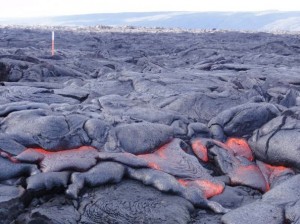Lava Again Approaching Ocean; County Prepares for Crowds
A lava flow from Kilauea is again approaching the Puna coast, and the county is preparing for the crowds of sightseers that invariably brings.
A report today from the Hawaiian Volcano Observatory said a flow was within 150 feet of the ocean in the Kalapana area.
If the flow reaches the shore, it will be the first time lava has entered the ocean since late December 2011.
Lava has entered the ocean periodically from two vents on Kilauea’s east rift zone since the volcano began its current eruption on Jan. 3, 1983. Since then, more than 500 acres of land have been added to the Puna coast.
The lava flow currently originates at the ‘Pu‘u ‘O‘o vent.
The flows travel in a subterranean tube network that channels the lava from the vent to the coast seven miles away.
The tubes are created as the skin of the lava cools and hardens, forming an insulating layer that allows the lava to flow further down the volcano’s slopes.

Lava has been slowly making its way across the Kalapana coastal plain toward the ocean, as seen in this photo taken on Nov. 10. The post in the rear left marks the boundary of Hawaii Volcanoes National Park. HVO photo.
Occasionally the tube network becomes partially disrupted, which can cause surface outbreaks.
Meanwhile, the county is getting ready for the crowds of people – tourists and local residents alike – expected to come to view the latest additions to the Big Island.
The county Department of Parks and Recreation recently signed a new contract with the company that provides personnel to assist lava-watchers in Kalapana.
Jan Guard Hawaii Inc. provides what the county calls “resource rangers” to monitor the area past the end of Highway 130.
Now that lava is again active near the shoreline, the county is determining if and how to provide public access to the flow area, said parks and recreation spokesman Jason Armstrong.
At this time, viewers are not to venture beyond the markers at the end of the highway, Armstrong said. The county is reviewing options as to how and where the access may be allowed.
He noted that the land on both sides of the highway and its lava-covered right-of-way – is privately owned.
The county does have access rights across certain properties related to past viewing activities, but public entry onto other properties is technically trespassing.
During past ocean entries, hundreds of sightseers daily have made the trip to the area to see lava stream into the ocean. The spectacle is most vivid at night.
Also, vendors offering refreshments and other items usually take the opportunity to hawk their wares to the crowds.
While the lava entering the ocean can be spectacular, it also can present a significant danger, scientists note.
Safe lava viewing usually requires maintaining a substantial distance from the entry point.
That’s because as the lava enters the ocean it creates deltas of rock particles that can collapse at any time, with little or no warning.
The collapse of these deltas, also called benches, can also result in steam explosions that can send hot rocks flying inland.
The benches can be huge. In 2005, a bench that had grown to 26 acres in size collapsed into the sea, taking with it eight acres of adjoining sea cliff.
The collapses can also be fatal.
In 1993, a bench collapsed with four people standing on it. Three managed to run onto stable ground but the fourth was never found.
Visitors to the area should also avoid the steam plume created by the interaction of lava and seawater as it contains tiny lava fragments and droplets of hydrochloric acid.













